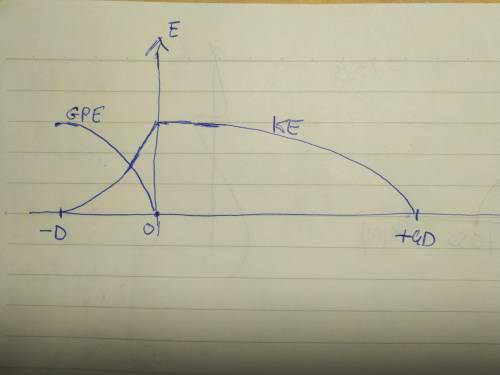
Physics, 22.04.2020 16:51 saintsfan2004
A block is initially at rest on top of an inclined ramp that makes an angle θ0 with the horizontal. The base of the ramp has a length of D . After the block is released from rest, it slides down the ramp onto a rough horizontal surface until it comes to rest at a position x=4D from the base of the ramp, as shown in the figure. There is negligible friction between the block and the inclined ramp, while the coefficient of kinetic friction between the block and the rough horizontal surface is μb .
(a) On the axes below, sketch and label graphs of the following quantities as a function of the position of the block between x=−D and x=4D . Calculations for values for the vertical axis are not necessary, but the same vertical scale should be used for both quantities.
i. The kinetic energy K of the block
ii. The gravitational potential energy Ug of the block-Earth system
(b) The block is released from the top of a new ramp that has a base length of 2D, but still makes an angle θ0 with the horizontal. A student is asked to predict whether the final horizontal position of the block will be twice as far from the base of the ramp compared to when it was released from the original ramp. The student reasons that since the block will be released from a new height that is twice as high as the original height, the block will have more energy when it reaches the base of the ramp, so it will slide farther along the right surface before stopping at a position x=8D.
i. Which aspects of the student’s reasoning, if any, are correct? If no aspect of the student’s reasoning is correct, write “none”.
ii. Which aspects of the student’s reasoning, if any, are incorrect? If no aspect of the student’s reasoning is incorrect, write “none”.
(c) Derive an equation for the new final position of the block. Express your answer in terms of D.
(d) In the following question, refer to the relationships written in part (c), not just the final answer obtained by manipulating those relationships.
For any correct aspects of the student’s reasoning identified in part (b)(i), how is the student’s reasoning expressed by your mathematical relationships in part (c) ?
For any incorrect aspects of the student’s reasoning identified in part (b)(ii), how do your relationships in part (c) correct the student’s incorrect reasoning?

Answers: 1


Other questions on the subject: Physics

Physics, 21.06.2019 17:10, seby77L
Aspecial electronic sensor is embedded in the seat of a car that takes riders around a circular loop-the-loop ride at an amusement park. the sensor measures the magnitude of the normal force that the seat exerts on a rider. the loop-the-loop ride is in the vertical plane and its radius is 23 m. sitting on the seat before the ride starts, a rider is level and stationary, and the electronic sensor reads 740 n. at the top of the loop, the rider is upside down and moving, and the sensor reads 370 n. what is the speed of the rider at the top of the loop?
Answers: 1

Physics, 22.06.2019 03:00, ronniethefun
1. a net force of 100 newton’s is applied to a wagon for 5 seconds. this causes the wagon to undergo a change in momentum of
Answers: 2


Physics, 23.06.2019 03:00, sierravick123owr441
The device shows the relative humidity at 22°c. what’s the water vapor density if the maximum water vapor in air at this temperature is 20 grams/cubic meter? a device showing that at 22 degrees celsius the relative humidity is 58%. a. 11.6% b. 11.6 g/m3 c. 12.76% d. 12.76 g/m3 reset next
Answers: 2
You know the right answer?
A block is initially at rest on top of an inclined ramp that makes an angle θ0 with the horizontal....
Questions in other subjects:




History, 27.07.2019 19:00

History, 27.07.2019 19:00


Mathematics, 27.07.2019 19:00


Mathematics, 27.07.2019 19:00

Health, 27.07.2019 19:00







 the initial total energy of the block at the top of the ramp.
the initial total energy of the block at the top of the ramp.
 is the height of the ramp.
is the height of the ramp.


 is the final speed of the block
is the final speed of the block is the acceleration due to friction
is the acceleration due to friction (1)
(1)
 in part a) and
in part a) and  in part b)
in part b)



